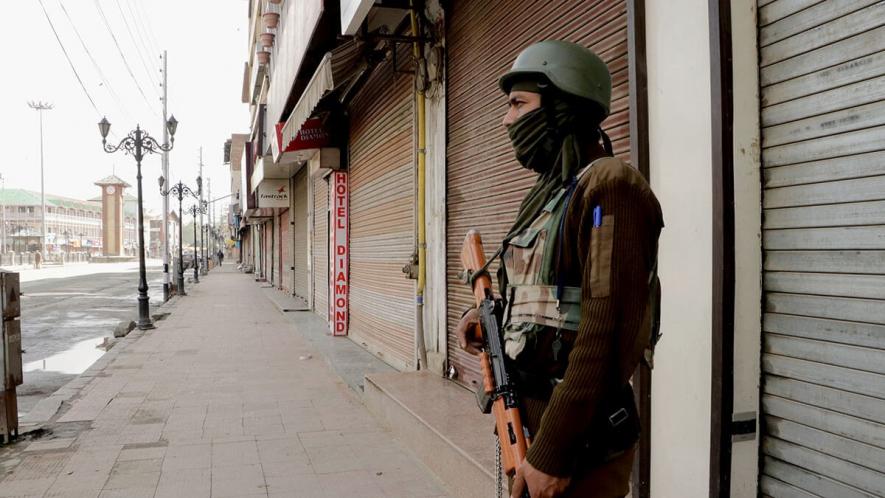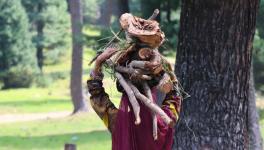What Normalcy Means In Kashmir’s Context

A time of crisis indeed. Even so, while dismal conditions prevail, an array of distractions are being thrown at people. Hollow assurances of all is well are pouring forth even as half the country’s population is simply at threat of being washed away. From Bihar and Uttar Pradesh horrifying pictures of the flood’s fury are emerging. With all the development we boast of, why have we been unable to harness these waters? Is it the faulty development model, or have these waters nowhere to go except into homes, schools, hospitals, offices and prisons?
Never mind if all’s getting washed away. Our rulers continuing to sing all is well lullabies, putting to sleep the thick-skinned. And for the hundreds of thousands caged in the Kashmir Valley, the rulers continue to sing the same song. There are tragedies unfolding in the Valley that raise no public outcry. Either the right-wing propaganda machine is working overtime on a well-executed strategy. Or, we are so completely conned or blinded (though not by pellet guns) that we cannot even comprehend basic truths. There is no other explanation for the strange disconnect between reality and lies.
What will happen if you treat citizens as suspects, not even allow them to be heard or listened to? The hapless citizens of the Valley cannot be heard. They cannot tell us of the dead or the dying. Even for those who are trying to send news from there, the going is tougher by the day.
That is why it is important to recall two rather significant reports, which brought into focus in 2018, what “normalcy” means in the context of Kashmir. The facts and figures in them are sorrowful and shocking—that is, if a reader’s sensitivity has not been totally demolished. It is important to figure out, from these facts and figures related to Kashmir’s un-caged days, what present-day conditions there would be like.
JKCCS report on child deaths
In 2018, the Jammu-Kashmir Coalition of Civil Society (JKCCS) released a report titled, Terrorized: Impact of Violence on the Children of Jammu and Kashmir. This report assesses the extent of violence against children in Jammu and Kashmir (J&K) between 2003 and 2017. It highlights also the grim reality that there are none or near-none legal and normative processes or practices that protect children’s rights in J&K.
In J&K, minors have been routinely booked under the repressive Public Safety Act (PSA), for example. “Children in J&K are living in the most militarised zone of the world, with the presence of 7,00,000 troopers, which exposes them to the risk of grave violations against children as laid out in United Nations Convention on the Rights of the Child.”
Over 15 years, between 2003 and 2017, 318 children in the age group of 1 to 17 were killed in J&K. These deaths constituted 6.95% of all civilian killings over the period. A total of 4,571 civilians were killed in violent incidents in the state over the same years. At least 16,436 killings were recorded in the state and a majority of them—at least 8,537—comprised alleged militants.
These numbers indicate that on average at least 1,095 were killed in the region every year. This raises the question as to what the government of the day means when it claims that J&K is “returning to normalcy” after close to two months under lock-down. The pattern of killings of children until 2017 suggests that children were direct targets of state violence. Surely, this is not the “normalcy” any regime would consider worth returning to.
That these children’s deaths were part of the state’s declared offensive against militancy and uprising is also clear. For, at least 144 minors were killed by the Indian armed forces and the state police. That is, nearly half (44.02%) of the total killed children died because they came under fire from armed personnel. Further, some 110 of them were shot dead and not less than eight died of injuries sustained when they were fired upon by government forces with pellet guns.
The report found that 27 children died to due drowning, either caused due to the negligence of armed forces (in Wular lake tragedy) or while they were being chased by government forces during protests. These victims possibly found no way to escape from the armed forces and jumped into water bodies, which resulted in their death, the report says.
Bad news for the media
In 2018, I heard the head of the Journalism Department of the Islamic University of Science and Technology (IUST), situated on the outskirts of Srinagar, in Awantipora, Dr Ruheela Hassan. She was speaking at a seminar held at the Jawaharlal Nehru University’s Centre for Media Studies. Her focus was on the difficulties faced by journalists in the Valley.
Her report on the subject says, “The media in Kashmir has never enjoyed real freedom. Be it the Dogra Rule in 1924, nationalist government from 1947 to 1953, Sheikh Abdullah’s rule from 1948 to 1953,Mohammad Bakshi (1953-1963) or Mohammad Sadiq from 1964-1971 or the National Conference government which has been in power from 1975 to 1982 and 1986 to 1990. The media in Kashmir has never breathed in free air.”
At one time the state was resistant to granting permissions to the media to function. When these permissions were granted, their freedoms were curbed and strict laws and regulations -- such as the J&K Press and Publication Act, 1932 -- were introduced. The law was implemented to ban publications, seize printing presses or demand heavy security from the journalists.
After India gained Independence, it guaranteed the freedom of speech and expression to all citizens including those in the state of J&K, but nothing changed for the press. Older laws were amended and new laws were implemented to muzzle their freedoms.
The circumstances in Kashmir from the 1990s onwards further worsened the scenario. Not only was the freedom of expression endangered, but there were now increased threats to the life of journalists. Their freedom of movement and right to access information was also snatched.
“Several journalists lost their lives and many were put behind bars. Journalists also fought several battles with the state. Some struggles they won (such as ensuring withdrawal of the Press Bill) and some they lost,” Hassan’s report says.
A survey in J&K has revealed that 77% of Valley journalists reported facing restrictions while performing their professional duties. And, 21% of them have been booked or summoned by either state or national authorities.
Mostly, they were summoned in order to be booked under draconian laws such as the Official Secrets Act, the PSA, and so on. Twenty journalists have been killed, several kidnapped and illegally detained and more than 25 injured. It should come as no surprise that “normalcy” in Kashmir means that 80% of Valley journalists do not believe that their freedom of expression is guaranteed.
On 2 October, let us pledge to speak the truth and also try and hear only the truth. Mahatma Gandhi’s biggest weapon was his strength to speak only and only the truth. Armed with that, he disarmed even heavily-equipped armies.
Humra Quraishi is a freelance journalist and commentator in Delhi. Views are personal.
Get the latest reports & analysis with people's perspective on Protests, movements & deep analytical videos, discussions of the current affairs in your Telegram app. Subscribe to NewsClick's Telegram channel & get Real-Time updates on stories, as they get published on our website.























